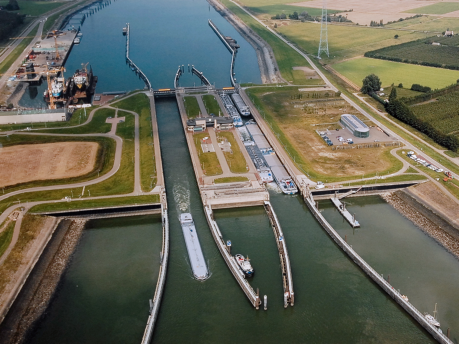Researcher: Stefan Bosveld
Project Duration: October 2009 – March 2010
Project Partner: Grontmij
Problem definition and research goal:
Infrastructure asset managers of waterways are aiming at improvement of their decision making and a more efficient organization of their workflow processes. For this, understanding of the relationship between strategic policy decisions and condition parameters for maintenance interventions at the operational is required. The insight in this relationship is in the current maintenance processes at waterway infrastructure asset managers not as wanted (Randstedelijke Rekenkamer, 2009; Rekenkamer Zeeland, 2009; Rijkswaterstaat, 2007; Grontmij, 2008). The research goal is therefore to develop an asset management model, which gives insight in the relationship between strategic policy decisions about quality of waterways and condition parameters for maintenance interventions at the operational level.
Research methodology:
The methodology by which the research goals is reached has been to first conduct a literature review, which gave the basis for the case study at three asset management organizations (province of Noord-Holland, of province Zuid-Holland, en Rijkswaterstaat Dienst Oost-Nederland). During the case study interviews and document research were performed. The analysis of the case study gave similarities and differences between the cases. Based on that a first version of the asset management model was developed and then tested by discussing it with experts and applying it on a section of the waterway network managed by the province Noord-Holland. The improvements which came to light during the workshop and test case were used to develop a second version of the asset management model.
Results:
The research resulted in a developed asset management model for maintenance of the banks and soils of waterways. The model is relevant to users at the strategic, tactical, and operational level within waterway infrastructure asset management organizations.
At the strategic level the quality of waterways is described with secondary functions and related lower order functions. At this level the waterway is divided into sections, based on the secondary functions accessibility, safety, and environment. At the tactical level the lower order functions from the strategic level are related to design and technical requirements for banks and soils. Also, the waterway sections are further divided into smaller sections, based on spatial (waterway objects) and functional (CEMT, trails, functions) criteria and a function weight has to be allocated to these smaller sections. At the operational level the design and technical requirements for banks and soils are related to component features of the different object categories of banks and soils. These component features are the same as the condition parameters, about which the quality inspectors collect information to use as input for the asset management model. Two methods for determining the level of quality of the component features are described in this report.
The secondary functions, lower order functions, design & technical requirements, and the component features are bilaterally related to each other. The input from inspections of the component features at the operational level can therefore be related to the secondary functions of the waterway at the strategic level. At the strategic level a better understanding of the quality of the waterway and the maintenance process, will result in improvements of their decision making and workflow processes.
Recommendations:
The first recommendation is to implement and use the developed asset management model, to gain results about the actual maintenance condition of waterway banks and soils and the relationship with that with the strategic policies at the strategic organization level within the maintenance process. Before applying the asset management model, the second recommendation is to divide the waterway into sections, based on functional and spatial criteria.
Third, the recommendation is to keep discussing the weight factor of each waterway section and component of the asset management model in the relation between the strategic, tactical, and operational level. This discussion keeps the waterway asset manager involved in understanding the maintenance process.
Fourth, it is important to recognize that besides the technical perspective on quality of waterways, there are other performance management perspectives on which maintenance of waterway banks and soils can be based. Recommended is to not only apply the asset management model as a technical perspective, but also use other performance management perspectives.
Fifth, the recommendation is to carefully acknowledge the differences between the users of the asset management model, to ensure a successful implementation and usage. Users at the strategic level describe the quality of the waterway in functional terms, the users at the operational level describe the quality of the waterway in technical terms, and the users at the tactical level link the functional and technical terms. By communicating in the right terms, the advice fits the perspective of the users and the asset management model will be adopted by them.
In conclusion, the sixth recommendation is to use a software tool, such as dgDialog, for managing the data collected during maintenance inspections of the waterway. The amount of data will be very large, and the danger from this is to lose understanding of the maintenance process.

